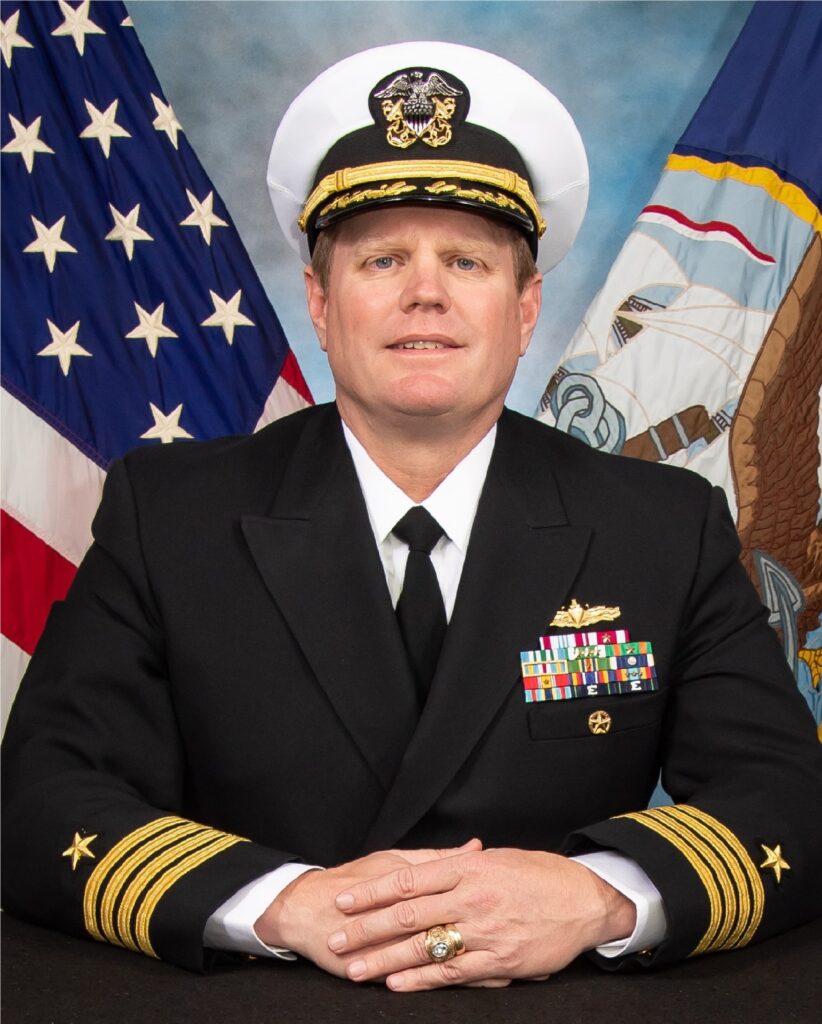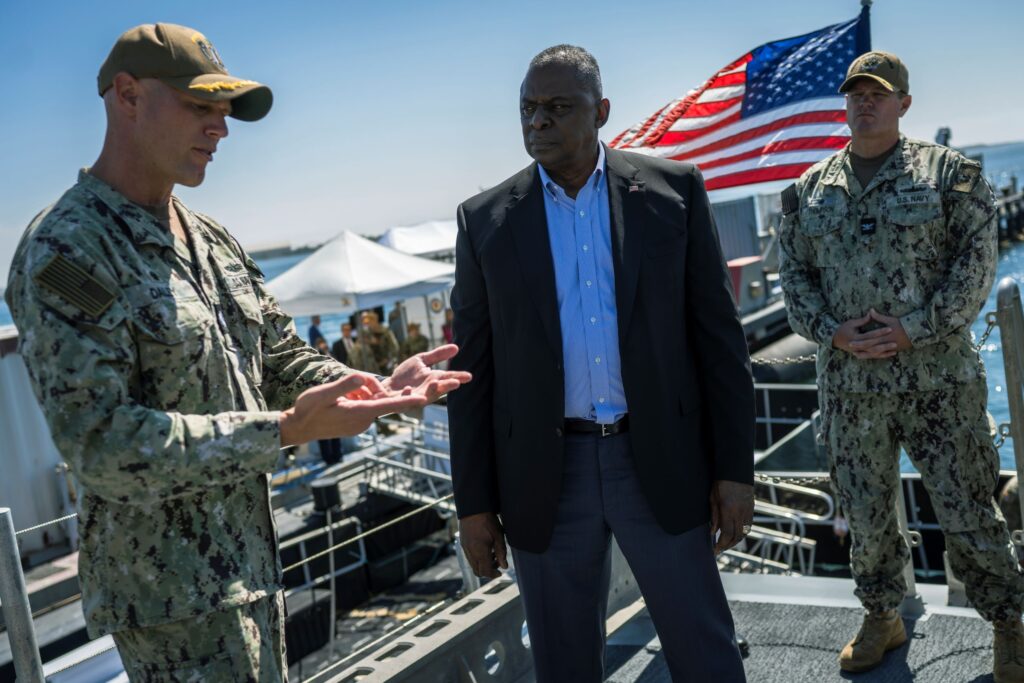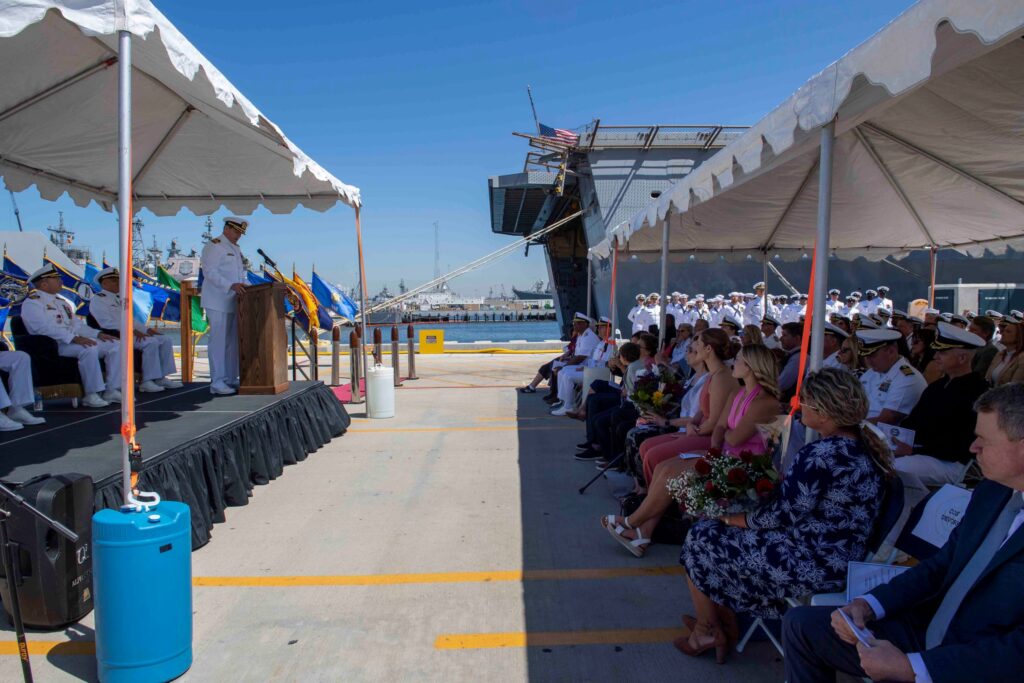
A native of San Marcos, California, Thompson received his commission from the U.S. Naval Academy in 1997. His sea tours included USS George Philip (FFG 12), USS Cape St. George (CG 71), and USS John Paul Jones (DDG 53). He served as executive officer and then commanding officer of USS Chafee (DDG 90). Subsequently he commanded USS Bunker Hill (CG 52).
Thompson’s tours ashore include Naval Postgraduate School where he earned a Master’s Degree in Financial Management; Ballistic Missile Defense Syndicate Lead at Tactical Training Group Pacific; Ballistic Missile Defense Training Officer at U.S. 3rd Fleet; Joint Interface Control Officer at Headquarters U.S. European Command (J3); C4ISR Operations Branch Chief at U.S. Strategic Command, Joint Force Component Command Global Strike (J6); N8/9 Branch Head Headquarters Surface and Mine Warfare Development Center.
Thompson discussed the roles of Surface Development Squadron One with Senior Editor Richard R. Burgess. Excerpts follow.
How did your background prepare you for your current command?
THOMPSON: Actually, my background prepared me quite well. Following my command tour on USS Chafee, I had the privilege of being assigned to the Surface and Mine Warfighting Development Center [SMWDC] where I served as N8/9 Branch Head for Future Requirements & Resources and Experimentation from 2016 to 2019. During that time, I had significant exposure to the acquisition and budgeting process as well as requirements generation. SMWDC’s Warfare Improvement Programs fell under my portfolio for those three years. We produced the surface fleet’s Integrated Prioritized Capabilities List for surface warfare Integrated Air and Missile Defense, Surface Warfare, Amphibious Warfare and Mine Warfare. That experience really benefited me as I became intimately familiar with the capability gaps across all those mission areas.
I’ve worked with a number of stakeholders to include the technical community on how we would get at closing those gaps and back in 2017, we recognized unmanned systems had a role to play in closing a number of gaps across those mission areas. The beauty was, as I also wore the N9 hat, I was able to partner with industry and experiment with new and innovative capabilities that helped close those gaps. For example, I personally worked closely with industry on the first-ever remote operation of Sea Hunter [unmanned surface vessel] from a surface combatant to validate that capability. So, the learning curve of employing and operating unmanned platforms with and from manned surface forces wasn’t that steep for me as I came into this job.
In fact, when I took command of SURFDEVRON, I was encouraged by the progress I saw had been made since my time in SMWDC and my time taking command here. We’ve come a long way since 2017 [with] the current and future capabilities and possibilities that exist with manned and unmanned teaming, how that will enhance the lethality of the surface force going forward.
How many personnel comprise your command?
THOMPSON: On staff here at SURFDEVRON I have 13 Officers, 58 enlisted, and one civilian permanently assigned. USS Michael Monsoor (DDG 1001) and USS Zumwalt (DDG 1000) each muster about 180 personnel. Obviously, I’m eagerly awaiting delivery of USS Lyndon B. Johnson (DDG 1002) when that day comes. USV Division 1 was formally established during the SURFDEVRON 1 change of command ceremony on May 13 and is now commanded by CDR Jerry Daley. That squadron has actually grown to 103 Sailors comprised of 12 officers and 91 enlisted. Those folks are there to provide dedicated support to USV operations.

How has the Chief of Naval Operations’ new Navigation Plan influenced the focus of your work?
THOMPSON: The CNO’s Navigation Plan is the guiding framework for my efforts for USV experimentation and fleet integration. In there, it talks about [how] unmanned surface platforms will increase the fleet’s capacity for distribution and expand our intelligence, surveillance and reconnaissance advantage, add depth to our missile magazines, supplement logistics, and enhance fleet survivability. This transition will gradually rebalance the fleet away from exquisite manpower-intensive platforms for smaller, less expensive yet lethal platforms. The capacity goal, if I remember correctly, is approximately 150 USVs.
That plan also emphasizes the importance of the manned/unmanned teaming in future fleet operations. We’re really getting at that. For example, one of the concepts we’re working on is further distributing the force through manned and unmanned teaming. Your typical surface action group, or SAG, consists of three destroyers. Right now, we’re trying to reimagine that traditional SAG. Instead of three manned DDGs making up that SAG, we’re exploring options to have one DDG as the center of a SAG teamed up with a number of unmanned surface vessels that would be one SAG. That also frees up the other two destroyers to create other manned/ unmanned SAGs and further distribute the force and enhance the capability and lethality of those SAGs as well. Honestly, I envision a future where this is the standard SAG construct and my team here is moving out full speed on proving out that concept.
What kind of experiments have you been working on with the Zumwalt-class DDGs?
THOMPSON: I would say that for the class, it’s been less about experimentation and more about class capability validation. That’s not to say we haven’t been leveraging those platforms for experimentation efforts.
I know you’re aware that Zumwalt is currently employed in the Indo-Pacific region, and she is working on fleet integration and participation in fleet exercises. We’re pushing her forward to learn how the ship can best operate and integrate with other fleet assets and how this integration is done at the tip of the spear. You can only do so much learning pierside. It is important to accelerate her introduction into fleet exercises and this learning is going to inform future employment of the class. Prior to this employment, Zumwalt went through your standard workups for employment, conducting basic training certification events and participating in the Surface Warfare Advanced Tactical Training, otherwise known as SWATT.
Earlier this year, Monsoor participated in an ASW [antisubmarine warfare] exercise known as SCC Mini-wars, and she did that with coalition partners and the USV Sea Hawk in the Hawaiian op area. Monsoor also recently participated in the first RIMPAC exercise for the class where, again, she focused on force integration and continued her work with unmanned vessels in that exercise.
Do you expect the Zumwalt DDGs to return to your squadron after their modification with the Conventional Prompt Strike capability?
THOMPSON: They’re going to come back to me following deployment and they’re going to be with me for the foreseeable future. The future plans for the class remain in work. We are gathering data right know regarding Zumwalt’s current deployment and Michael Monsoor’s RIMPAC support. We’re going to leverage that data and lessons learned on any future deployments to include how to maintain and sustain the platform in an operational environment when deployed forward. I will say the best way to continue learning and validating the existing capabilities and TTPs [tactics, techniques and procedures] for the class is to keep them underway and employed, whether that’s with 3rd Fleet or 7th Fleet.
What kind of things are you doing with the two Overlord USVs and what are you planning in the future once the other two Overlord USV are on strength?
THOMPSON: All four of the USVs that I own right now were involved in RIMPAC: Sea Hunter, Sea Hawk, Nomad and Ranger. Their involvement in RIMPAC really helped determine and define how the capabilities of the unmanned fleet will integrate with our manned ships. RIMPAC was an excellent arena to showcase the USVs’ usefulness in electronic warfare, data collection and how warships can leverage USVs in the high-end fight. In every exercise we do from SCC mini wars to SWATT to RIMPAC, the objectives being accomplished form the building blocks of realizing the manned/unmanned concept. A USV tracking a submarine using its ASW payload or providing target-quality tracks to a surface combatant — think EW [electronic warfare] payloads, sensor suite, etc. — we’re proving the USV is value added in providing our warships with more flexibility in meeting the mission.
How about your experimentation with Sea Hunter and Sea Hawk USVs?
THOMPSON: They each bring different payloads and capabilities. And so, we’re working with those to further validate our concepts. For the broader unmanned campaign plan, Surface Development Squadron One is developing those concepts in the playbooks, in the TTPs and we’re doing that with other stakeholders. We’re not doing that in a vacuum. I see those concepts and TTPs playing in the potential surface battles of tomorrow. The prototype USVs are being heavily leveraged to validate these concepts and TTPs. When the program of record USV does come online, we can quickly transition it into fleet operations. The goal to me will be for them to be embedded into fleet operations to further distribute the force, provide manned warships with target quality tracks and, also, for adjunct magazines.
One important note I think is worth mentioning is we’re focused on autonomous USVs with a man-on-the-loop technology. That means that even though a USV may be in an autonomous mode while conducting a mission, it is always being monitored — including its health status — and at any time the man-on-the-loop, whether on board a ship or shore, can take direct control as required.
Are there any specific accomplishments you want to mention with regard to the USVs or the Monsoor in RIMPAC?
THOMPSON: Sea Hawk was out during the SCC Mini-Wars and did excellent work. She validated the value of her ASW payload. Not just here at the Echelon 5 level but all the way into the Echelon 2 level. In the near future, we’re participating in a fleet exercise that we’ll explore how that capability supports our expeditionary capability and the Marine Corps’ efforts on that front, too. The big ship-to-shore movement of USVs’ C2 [command and control] nodes, officially we’re working with PMS-406 to gain unmanned, unescorted, OTH [over the horizon] proof-of-concept testing.
For Monsoor, RIMPAC was really a test of the operational concepts and to gather insights about further employment for the class. She flexed her capabilities across all mission areas to include SUW, ASW, and air defense. She also conducted an experiment that consisted of launched employment and recovery of a UAV to enhance maritime surveillance. All four USVs that participated in RIMPAC demonstrated how they fit into the composite warfare commander concepts either attached to a destroyer or sent out on individual missions. It really helped to determine how the capabilities of the unmanned fleet integrate with our manned ships, with focus on ASW, EW, surface warfare, interoperability and transfer of control of those USVs between manned ships and ashore or vice versa.

With the Navy developing the Next-Generation Destroyer (DDG(X)) and the Large USV, are you actively engaged in providing feedback for development of those vessels?
THOMPSON: Yes. As we worked fleet introduction for DDG 1000 class and the USVs, there are a number of lessons learned that can be applied to both the DDG(X) and LUSV, not just from a capability validation perspective but also from a maintenance and sustainment perspective. And so, those lessons are being shared across the enterprise. The LUSV program is in the prototyping stage while we develop and demonstrate the technology for critical subsystems, through a comprehensive land-based and afloat test program across HM&E [hull, mechanical and engineering], C2, autonomy, perception and integrated combat system aspects prior to moving into serial production. By the end of 2023, we expect to have seven USV prototypes operating under the direction of Surface Development Squadron One and that’s in partnership with PMS-406 and the USV Program Office.
USVs are planned to be the high-endurance adjunct [missile] magazine based on commercial designs built around the common missile launcher and combat systems. The initial capability will be to support both surface warfare and strike warfare, but I anticipate that being expanded and air defense as well. The six LUSV studies contracts were awarded in September of this year. Those contracts are going to help refine specifications and requirements to inform future LUSV detail design and construction.
What advances have you seen in unmanned operations technology and sustainment since your squadron was established?
THOMPSON: Since Surface Development Squadron One was established, the advances I am most encouraged by are, we’ve got much more confidence in safe autonomous operations. We’ve been out and operating with these platforms for a long period of time. That resiliency really translates to increased on-station time, our abilities to control from ship or shore or, again, transfer control from ship-to-shore and vice versa. The capabilities of the various payloads for USVs provide the operators and leadership the confidence that manned/unmanned teaming does, in fact, enhance the lethality of the surface force.
I really believe it’s a game-changing concept, not only for the future force structure but from a tactical, operational and strategic perspective. Those are the big differences I see from back in 2017 when I was just proving out that I can actually operate a USV from a destroyer to where we are today. I’ll tell you that with the USV prototypes, we’re rapidly expanding their participation in the exercises as well as conducting independent operations such as a recent missile test from an Overlord USV. The maturing fleet experimentation and testing program only serves to increase the fleet’s knowledge on USV integration and operational and infrastructure support requirements.
What do you see as the remaining challenges of deploying, operating, and sustaining USVs?
THOMPSON: Well, you know, we’re going to continue working to make the USVs more reliable and sustainable through experimentation, lessons learned, testing, evaluation and increased employment. You can’t learn when those things are pierside, so we got to keep pushing them out there. Every USV underway hour provides us additional data and learning opportunities that support the maturation of economy and reliability. I said that one of the encouraging things was an increased confidence level and the safe autonomous operations. We still have some work to do in that area. Obviously, COLREGS [International Regulations for Preventing Collisions at Sea 1972] remains a focus area for the program. Today, the autonomy and reliability conduct vessel avoidance for 1v1 [one versus one] COLREGS encounters. However, we’re still got some work to do in complying with the full scope of COLREGS. That’s the hierarchy of vessels, low visibility compliance, autonomous lights, autonomous sound signals, etc.
- BlueHalo to Test C-UAS System on Marine Corps JLTV - April 29, 2024
- USS George Washington Deploys to U.S. Southern Command, Eventually Headed to Japan - April 26, 2024
- SECNAV Advocates Increased Legal Immigration to Increase Shipbuilder Workforce - April 23, 2024



